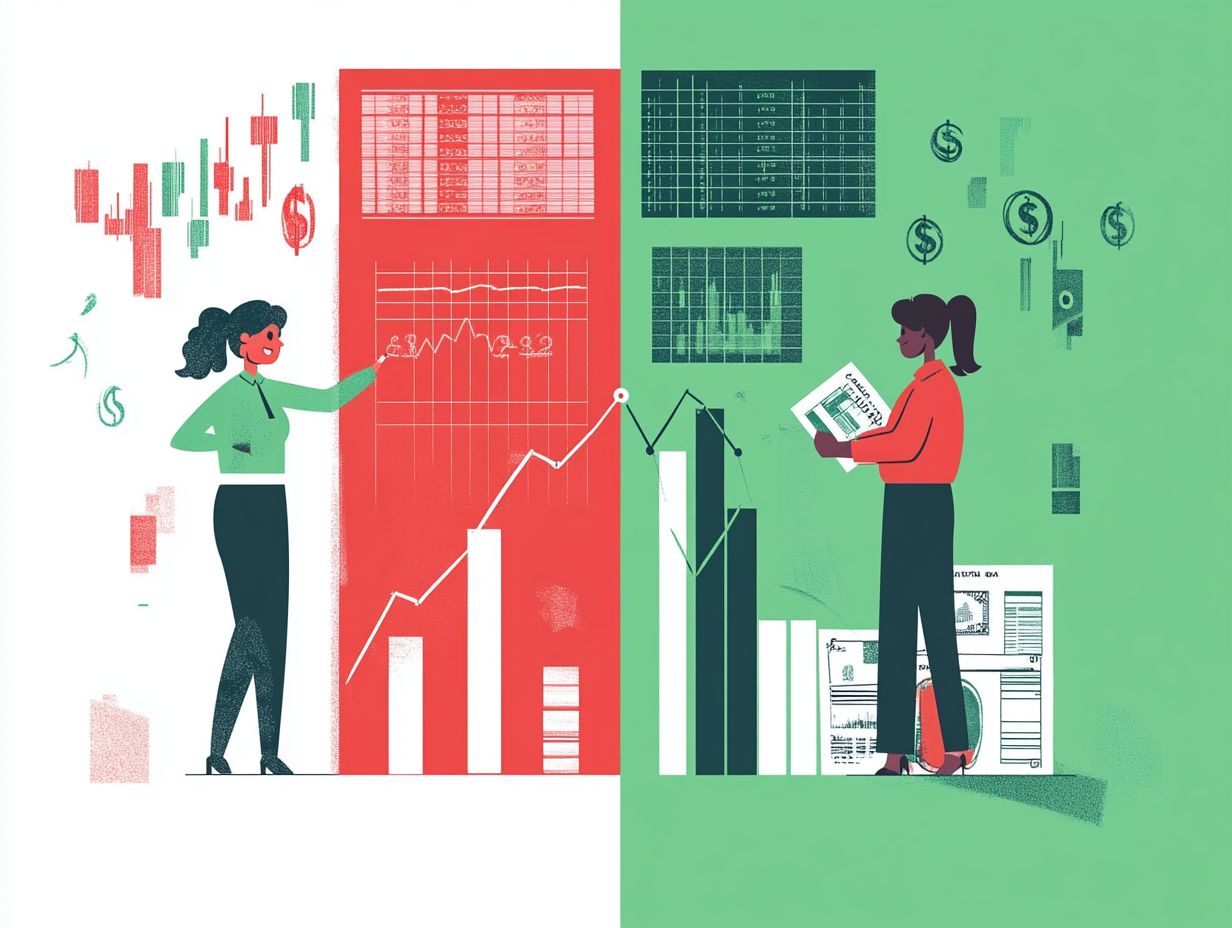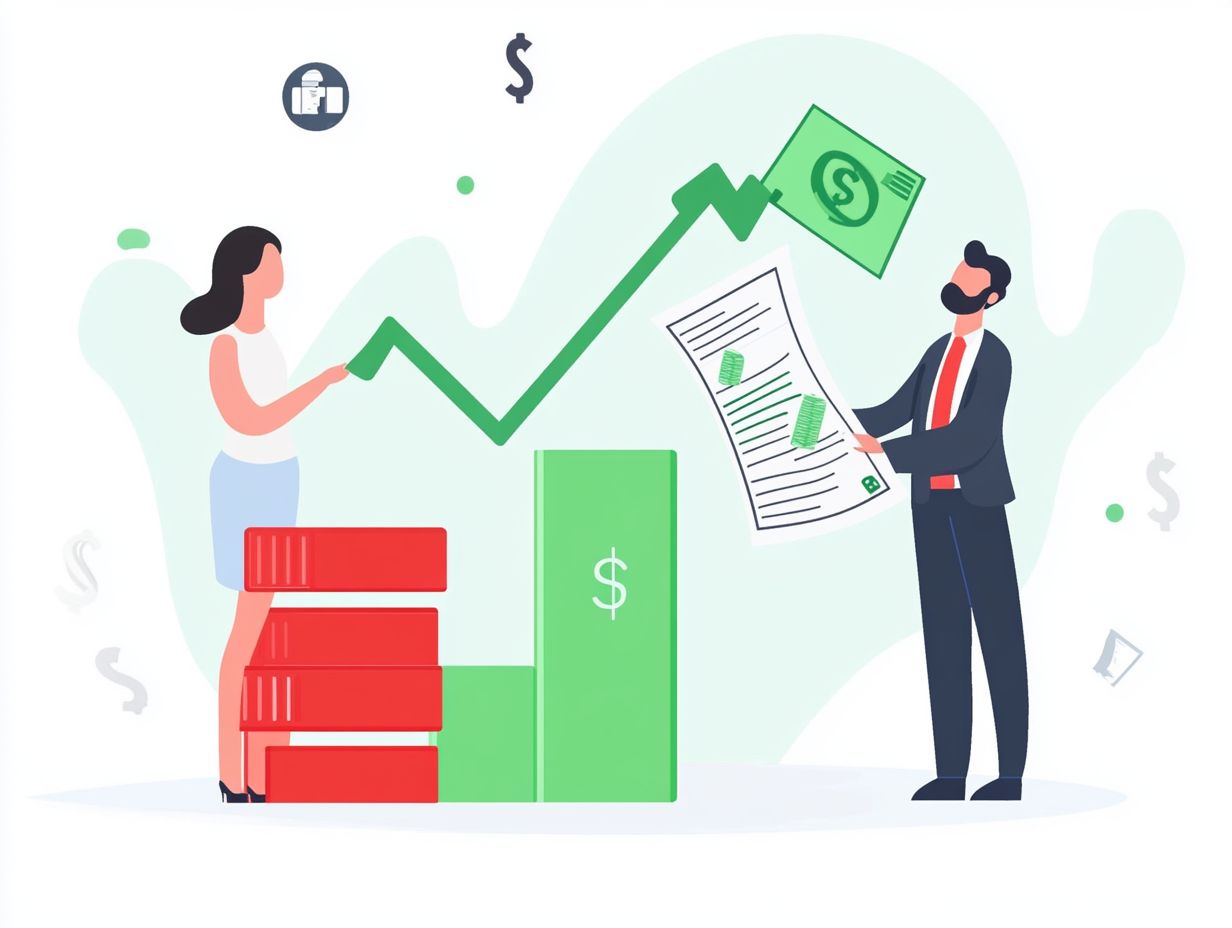Pros and Cons of Peer-to-Peer Lending Explained
Peer-to-peer lending has benefits and challenges for everyone involved. It has become a compelling alternative to traditional banking, facilitating direct connections between borrowers and individual investors.
This simple way to borrow and lend money presents unique advantages and challenges for all parties. You will explore what peer-to-peer lending truly entails, weighing its pros and cons.
The discussion will cover the benefits for both borrowers and investors, potential risks, and crucial factors to consider before you take the plunge.
Whether you’re considering borrowing or investing, grasping the nuances of this system is essential for making informed decisions. Act now to take advantage of competitive rates!
Contents
Key Takeaways:

Peer-to-peer lending allows individuals to borrow and lend money directly with each other, bypassing traditional financial institutions. For borrowers, peer-to-peer lending can offer lower interest rates and more flexible terms.
For investors, it can provide higher returns and diversification in their portfolio. However, there are also risks involved in peer-to-peer lending, such as the chance that borrowers won’t pay back their loans and platform stability. To navigate these challenges, it’s essential to grasp understanding the market trends in peer-to-peer lending.
It is important to carefully consider your risk tolerance and thoroughly research before participating.
What is Peer-to-Peer Lending?
Peer-to-Peer (P2P) lending presents a simple way to borrow and lend money, connecting you directly with individual investors or multiple lenders through reputable online platforms like LendingClub, Prosper, and Upstart. For more information, check out the top 10 FAQs about peer-to-peer lending.
By bypassing traditional financial institutions such as banks or credit unions, this innovative approach gives you the power to secure personal and business loans at competitive interest rates.
Meanwhile, it also provides investors with the chance to diversify their investment portfolios, potentially reaping higher returns through interest payments.
Definition and Overview
P2P lending, which stands for peer-to-peer lending, represents a simple method of borrowing and lending that unfolds on digital platforms. It seamlessly connects you, the borrower in need of funds, with investors eager for high fixed-income opportunities.
This approach bypasses traditional intermediaries like banks, allowing you to engage directly with others in the market. As a borrower, you can access a variety of loan types, from personal loans designed for debt consolidation or major purchases to small business loans that nurture startups and growing enterprises.
You can find competitive interest rates in this system, while investors enjoy appealing returns through a range of diverse investment opportunities. Ultimately, this collaborative approach cultivates a sense of community, revolutionizing how you and others access capital and fulfill your financial aspirations.
Pros of Peer-to-Peer Lending
Peer-to-peer lending opens up exciting advantages for both borrowers and investors. To fully leverage this opportunity, it’s crucial to grasp the understanding peer-to-peer lending fees and costs, as it fundamentally reshapes how individuals access loans and invest their capital in today’s competitive financial landscape.
By harnessing this innovative model, you can unlock new opportunities that redefine traditional financial interactions.
Advantages for Borrowers
For borrowers like you, P2P lending offers a streamlined online application process that often leads to competitive interest rates, presenting a compelling alternative to traditional lenders.
This approach enables you to bypass the lengthy approval procedures that banks typically impose, which can feel slow and frustrating.
Instead, you can quickly secure loans that consider not just your credit score but also your entire financial history, allowing for more personalized assessments.
The platform provides a range of loan options tailored to various needs from personal loans to debt consolidation ensuring you find a solution that aligns perfectly with your circumstances.
This blend of flexibility and efficiency makes P2P lending particularly attractive for those in need of prompt financial assistance.
Benefits for Investors

As an investor in P2P lending, you have the opportunity to enjoy attractive higher returns on your investments while simultaneously diversifying your portfolio with multiple lending opportunities across various borrower profiles.
This unique framework gives you the power to carefully evaluate the risks associated with different borrowers. It allows for thorough due diligence before you commit your funds.
By gaining a clear understanding of each borrower’s creditworthiness and repayment capacity, you can align your investments with your personal risk appetite and financial goals.
The flexibility of this platform enables you to adjust your investment strategies over time, which is especially beneficial if you’re aiming for long-term growth or require short-term liquidity.
Such tailored approaches can significantly enhance your profitability, ensuring that you maximize your potential returns.
Cons of Peer-to-Peer Lending
Peer-to-peer lending offers a range of enticing benefits, as detailed in what are the benefits of peer-to-peer lending?, but it also carries inherent dangers for both borrowers and investors.
Among these dangers are the potential for loan defaults and the complexities of regulatory challenges that one must navigate carefully.
Potential Risks for Borrowers
When you engage in P2P lending, it s crucial to be aware of the potential risks. This includes the possibility of loan defaults especially if you have a low credit score or struggle to meet repayment terms.
Understanding how your credit score influences loan approval is crucial; a lower score often translates to higher interest rates or even outright rejection from lenders.
It s vital for you to read and fully grasp the repayment terms associated with your loans. Missing payments can lead to steep penalties and further damage your credit rating.
This lack of awareness can trap you in a cycle of debt, so it s essential to weigh the benefits against these potential pitfalls before you take the plunge into the P2P lending arena.
Challenges for Investors
As an investor in P2P lending, you may face several challenges, such as managing the risk of loan defaults and conducting diligent risk assessments when selecting borrower profiles.
These challenges become even more pronounced in the unpredictable lending landscape, where missed payments can lead to financial setbacks. It’s essential for you to understand the platform’s regulatory oversight, as this knowledge will help you navigate the legal complexities and bolster your confidence in your investments.
Evaluating each platform s track record, fees, and underwriting criteria can offer you valuable insights. By actively engaging in thorough research, you can significantly reduce the risks associated with loan defaults and cultivate a more successful and sustainable lending experience.
Factors to Consider Before Participating in Peer-to-Peer Lending
Before you take the plunge into this exciting opportunity, think carefully about a few key factors. Reflect on your risk tolerance, clarify your investment preferences, and explore the various types of loans available to you.
Taking these elements into account will empower you to make informed decisions that align with your financial goals.
Assessing Your Risk Tolerance

Assessing your risk tolerance is essential when contemplating participation in P2P lending, as it guides the types of loans and borrowers you might engage with across various lending platforms.
Understanding your personal and emotional threshold not only influences the selection of lending opportunities but also determines how much you are willing to invest or borrow. If you have a high risk tolerance, you might find yourself drawn to loans that offer higher interest rates, tempted by the potential for increased returns.
On the other hand, if your risk appetite is more conservative, you may prefer safer, lower-yield loans that offer more stability.
Finding the right balance between risk and reward is crucial; it requires a thorough evaluation of borrower profiles, economic conditions, and the likelihood of loan default. Manage risks effectively. This approach increases your chances of favorable returns while minimizing potential losses.
Evaluating the Platform and Loan Options
When engaging in P2P lending, it s essential to assess the platform and the various loan options available. Ensure they align with your financial objectives and risk tolerance.
In this competitive arena, closely examine factors like interest rates. These can dramatically influence your overall returns and can vary significantly from one platform to another.
Understanding different borrower profiles will provide valuable insights into the associated levels of risk. This is vital for making well-informed decisions. Don t overlook the regulatory framework governing these platforms; stronger regulations often serve as a safety net against potential setbacks.
Familiarizing yourself with the nuances of the application process will give you the power to navigate your lending journey with increased confidence and clarity.
Is Peer-to-Peer Lending Right for You?
Determining whether P2P lending is the right fit for you requires a thoughtful assessment of your financial situation, investment timeline, and readiness to navigate the details of this new lending method.
As you explore this landscape, reflect on your personal financial goals. Decide if you are seeking steady income or long-term growth.
Know your risk tolerance. P2P lending can mean different risks for different people, especially when it comes to borrower defaults, which occurs when people fail to repay their loans. Talk to a financial advisor for personalized insights that help you balance the benefits against potential risks.
Learn about the platforms and their rules. This helps you make smart choices that harmonize with your broader financial strategy.
Frequently Asked Questions
What is peer-to-peer lending and how does it work?
Peer-to-peer lending, also known as P2P lending, is a form of borrowing and lending money directly between individuals without the involvement of a traditional financial institution. Online platforms connect borrowers in need of a loan with investors looking to lend money and earn interest. These platforms handle loan disbursement, repayment, and collection of interest and fees.
What are the pros of using peer-to-peer lending?

One major advantage of peer-to-peer lending is that it offers borrowers an alternative to traditional bank loans. P2P loans often have lower interest rates and more flexible repayment terms, making them a more affordable option for those in need of funding. To fully grasp this innovative approach, it’s important to understand the peer-to-peer lending process. P2P lending can also be a good investment opportunity for individuals looking to earn higher returns on their money compared to traditional savings accounts or CDs.
What are the cons of using peer-to-peer lending?
One of the main downsides of peer-to-peer lending is the lack of government insurance and regulation. Unlike traditional banks, P2P lending platforms are not backed by the government, which means there is a higher risk of default or loss of investment. Borrowers may also face higher interest rates and fees if they have a lower credit score or limited credit history.
Is peer-to-peer lending safe?
While peer-to-peer lending carries some risks, platforms typically have measures in place to reduce default chances, such as credit checks and diversification of investments. It is important for both borrowers and investors to carefully research and select a reputable P2P lending platform. Thoroughly read all terms and conditions before participating.
Can I use peer-to-peer lending for any type of loan?
Peer-to-peer lending can be used for a variety of purposes, such as personal loans, small business loans, and debt consolidation. However, some P2P lending platforms may have restrictions or limitations on the types of loans they offer. Check with the specific platform for their loan options and requirements.
What happens if the borrower defaults on their P2P loan?
If a borrower fails to repay, the lending platform will typically attempt to collect the funds through various means, such as hiring a collection agency or taking legal action. Investors may also have the option to sell their loans to other investors on the platform. However, there is no guarantee that the investment will be recovered in full.






